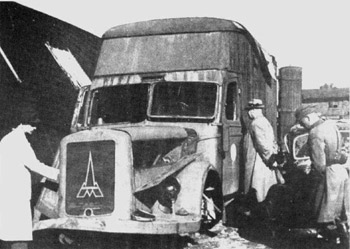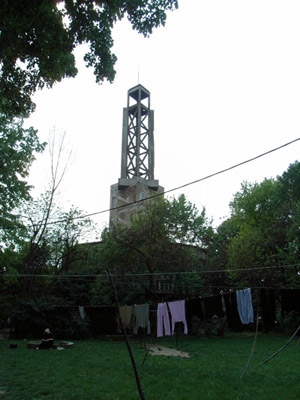 A mobile gas van similar to the one used for the murders at Sajmiste
This Monday (27 January) is International Day of Commemoration in memory of the victims of the Holocaust. On that day in 1945, Soviet troops liberated Auschwitz, the largest Nazi concentration camp where in the preceding three and a half years around a million Jews were systematically murdered, mainly in gas chambers.
A mobile gas van similar to the one used for the murders at Sajmiste
This Monday (27 January) is International Day of Commemoration in memory of the victims of the Holocaust. On that day in 1945, Soviet troops liberated Auschwitz, the largest Nazi concentration camp where in the preceding three and a half years around a million Jews were systematically murdered, mainly in gas chambers.
In countries which have adopted this day of commemoration, ceremonies and educational events will be held in honour of the six million Jewish victims of Hitler’s regime, but also millions of non-Jews who perished at the hands of the Nazis and their collaborators between 1933 and 1945.
Although many countries, including the United Kingdom, have had their own Holocaust memorial day for longer, the International Day of Commemoration was first introduced by the United Nations General Assembly in 2005.
Its main purpose was to encourage the remembrance of the Holocaust internationally, thus helping to ensure that the victims of the Nazi genocide are never forgotten and promoting the values of tolerance and human rights.
Camp for Jews
Over the past few years, I have been involved in a project which seeks to promote the memory a little known Nazi concentration camp called Sajmište (or Semlin in German). The camp was located in the Serbian capital Belgrade.
Established by Nazi Germany in December 1941 in the pavilions of what before the occupation were the Belgrade fairgrounds, Sajmište was the largest concentration camp on Serbian territory and one of the first Nazi camps in Europe created specifically for the mass internment of Jews.
Between December 1941 and March 1942, approximately 7,000 Jewish women, children and the elderly - almost half of the total Jewish population of the part of Serbia which was under direct German occupation - were brought to what was known officially as the Semlin Judenlager: the camp for Jews.
Gas van
 The camp as it looks now
In the spring of 1942, in just six weeks, all the Jewish inmates were systematically murdered by the use of a mobile gas van. The van, brought from Germany, was a normal truck whose exhaust pipe was adapted in a way that allowed the fumes to be diverted into the sealed compartment at the back.
The camp as it looks now
In the spring of 1942, in just six weeks, all the Jewish inmates were systematically murdered by the use of a mobile gas van. The van, brought from Germany, was a normal truck whose exhaust pipe was adapted in a way that allowed the fumes to be diverted into the sealed compartment at the back.
Once the exhaust pipe was placed in the required position, a 10-15 minute ride was enough to kill as many as 100 inmates locked in the back. Day after day, the van drove groups of prisoners through central Belgrade, poisoning them on the way to a site on the other side of the city, where the bodies were buried in mass graves.
Given that Serbia’s male Jewish population had already been executed in mass shootings carried out by the Nazis the previous autumn, as soon as the gas van completed its deadly mission in Belgrade, Serbia was declared ‘Judenrein’ – cleansed of Jews.
Soon after, Sajmište became an Anhaltelager, a temporary detention camp for political prisoners, captured partisans and forced labourers. Of the 32,000 inmates who were brought to the Anhaltelager (most of whom were Serbs), around a third perished at the camp, mostly from starvation, exposure, or disease, or were murdered by the guards and members of the camp administration. The others were transported to labour camps throughout the Third Reich, mostly in Germany and Nazi-occupied Norway.
Forgotten
Although Sajmište was a relatively small camp, the fate of Jews who perished there has attracted significant interest from historians of the Holocaust. The use of the gas van in the spring of 1942 is recognised as an important landmark in the escalation of the Nazi policy towards Jews.
Events in Belgrade were in many ways a prelude to the so called ‘Final Solution’, and one of the first signs that by the spring of 1942, the broader plan to destroy European Jews was under way.
What made me especially interested in Sajmište is the fact that, in spite of its importance as a place of the Holocaust, it is a largely forgotten camp. Over the years, relevant institutions in Serbia have failed to appropriately honour its victims or preserve the memory of their suffering.
Unaware
Today, 75 years after the end of the Second World War, the site where the camp was located, locally known by the name Staro Sajmište – the Old Fairgrounds - stands practically in ruins.
The former camp complex is a derelict and impoverished settlement, inhabited by a few hundred families who maintain the dilapidated buildings and unpaved paths, often at their own expense.
Scattered among the residential properties are several artists’ ateliers (remnants of an artists’ colony that existed there in the 1950s), but also car repair shops, stores, warehouses and workshops – as well as a high school, tourist agency, bookshop, restaurant, even a small stage which for the past ten years has served as a venue for rock concerts, boxing matches, theatre plays and dances.
Far too many residents of the Serbian capital remain unaware that less than a mile from downtown Belgrade are the remnants of a Nazi concentration camp, and the single most important site of the Holocaust in Serbia.
Invitation
The main aim of my project has been to explore the reasons behind this longstanding attitude of neglect, but also raise awareness, both in Serbia and internationally, of the importance of Sajmište as a place of memory.
As part of this project, I have created a website devoted to the Holocaust in Serbia and the history and memory of Sajmište (www.semlin.info).
Given the approaching International Day of Commemoration in memory of the victims of the Holocaust, I would like to invite you to visit the website, find out more about this largely forgotten place of suffering and in doing so help to rescue its victims from neglect and oblivion.
Rate and Review
Rate this article
Review this article
Log into OpenLearn to leave reviews and join in the conversation.
Article reviews
However, for the sake of today's Jewish people it's important that courses like this exist to acknowledge their persecution.